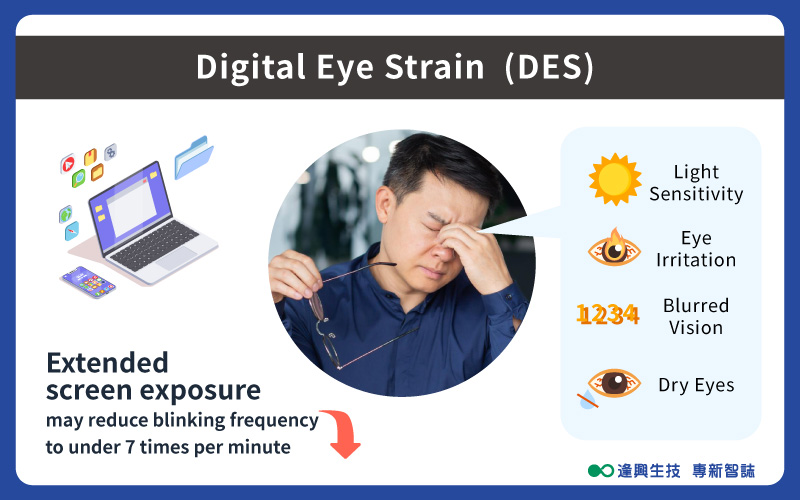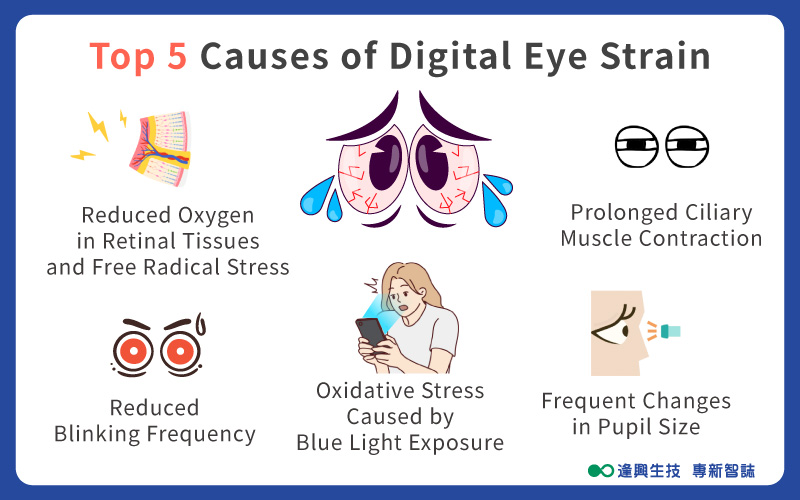Written by: Nutritionist Li-Wen Chen — February 21, 2025
Digital Overload Fuels Eye Fatigue from Screens—Quick Eye Health Solutions Give You a Competitive Edge
Since the digital revolution began in the 1980s, screens have become central to daily life. From smartphones and computers to tablets, digital devices are now essential for work, study, and entertainment. The COVID-19 pandemic further accelerated this trend, making remote work and online learning the norm. However, this growing digital dependence has raised a new health concern: Digital Eye Strain (DES).
According to the American Optometric Association, just two hours of screen time can impair ocular microcirculation, leading to symptoms such as dryness, blurred vision, burning sensations, and light sensitivity. Blinking frequency decreases from a normal rate of approximately 22 ± 9 times per minute to fewer than 7 ± 7 times. Incomplete blinking worsens dryness and heightens sensitivity to light and oxidative stress in the retina, increasing the risk of macular degeneration and visual aging.
In today’s screen-centric world, supporting microcirculation and enhancing ocular health with effective ingredients has become a crucial strategy for gaining a competitive edge in the eye care market.
https://www.aoa.org/healthy-eyes/eye-and-vision-conditions/computer-vision-syndrome?ss0=y&sso=y

Physiology Behind Eye Fatigue: How Technology Is Advancing Vision Health
Eyes getting tired from computer screens aren’t caused by a single factor, but by a combination of physiological mechanisms. At its core, the problem involves impaired blood circulation and oxidative stress.
The physiological mechanisms of eye fatigue:
- Ciliary Muscle Strain: Prolonged focus on screens causes continuous contraction of the ciliary muscles, leading to muscle fatigue, disrupted ocular blood flow, and increased intraocular pressure—resulting in eye soreness and visual fatigue.
- Blue Light–Induced Oxidative Stress: Blue light penetrates deep into the retina, generating free radicals that damage retinal cells and increase the risk of macular degeneration.
- Retinal Hypoxia and Oxidative Buildup: Eye fatigue form screens can constrict retinal blood vessels, reducing oxygen supply and promoting an oxidative environment—factors that elevate the risk of macular degeneration.
- Frequent Pupil Adjustment: Constant changes in screen brightness and contrast force the pupils to readjust repeatedly, leading to increased neural load and visual discomfort.
- Reduced Blinking Frequency: Screen use significantly decreases blink rate—often dropping below 7 blinks per minute, disrupting the tear film and accelerating ocular surface dryness.
As consumer demand for quick and effective eye health solutions surges, brands must innovate to stand out. Wel-Bloom meets the need of eye pressure support supplements with sublingual and submicronization technologies, along with smart ingredient selection backed by a proprietary database containing tens of thousands of ingredient records. Paired with sustainable, next-generation anthocyanin sources, this approach brings eye care into a new era—one that enhances ocular microcirculation and supports sharper, clearer vision.
https://pmc.ncbi.nlm.nih.gov/articles/PMC9434525/



